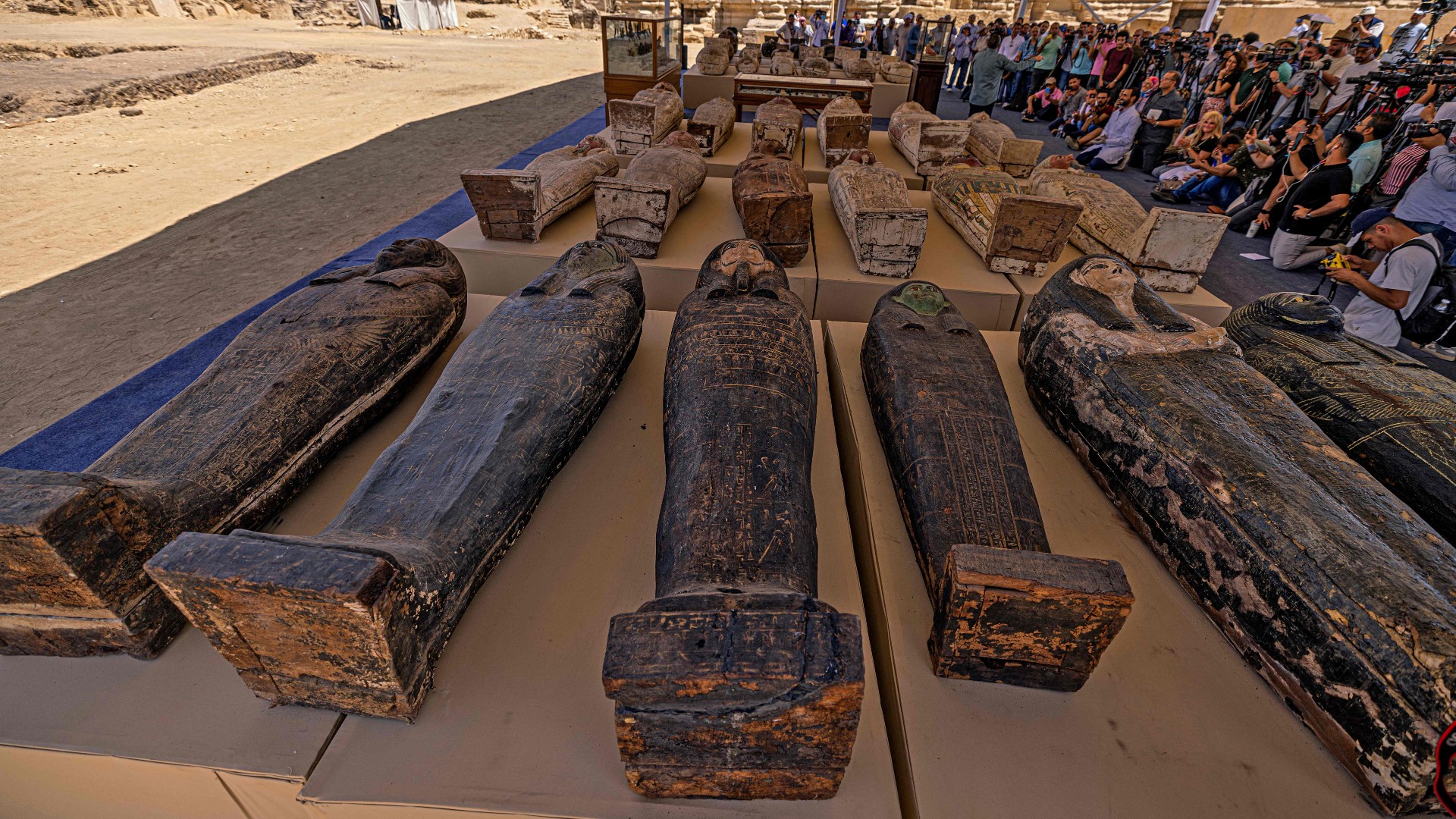Hundreds of ancient Egyptian sarcophagi, cat mummies and gold-leafed statues unearthed at necropolis
Archaeologists have unearthed a trove of artifacts at the necropolis of Saqqara near Cairo.

Archaeologists in Egypt have unearthed a trove of artifacts at the ancient necropolis of Saqqara, including 250 complete mummies in painted wooden sarcophagi and more than 100 bronze statues of ancient Egyptian gods.
The artifacts date to around 2,500 years ago, during Egypt's Late Period, according to a statement from Egypt’s antiquities ministry.
The trove was found at Saqqara's "Cemetery of Ancient Animals," a temple complex outside Cairo once dubbed "Bubasteion" — a reference to the ancient Egyptian goddess Bast or Bastet, who was worshiped there in the form of a cat, CBS News reported. The complex was renamed in 2019, however, after archaeologists discovered other types of mummified animals and statues of different Egyptian gods there.
Related: Why were the ancient Egyptians obsessed with cats?
"Today's discovery confirms that the temple wasn't exclusively for cats, but for other Egyptian deities too," the director of the excavations, Mohammed Al Saidi, told CBS News.
Egyptian authorities revealed the discovery on Monday (May 31), lining up the mummies, statues and other artifacts in front of Saqqara's Step Pyramid of Djoser for the announcement.
The necropolis at Saqqara is near the edge of a desert plateau about 15.5 miles (25 kilometers) south of Cairo. The ancient burial ground has been the site of extensive excavations by Egyptian archaeologists since 2018. Today's news is the fifth major announcement of artifacts that have been found there — including 59 mummies found in 2020, as Live Science previously reported — and there are still many years of work left to carry out.
Get the world’s most fascinating discoveries delivered straight to your inbox.
Egyptian culture
The Achaemenid Persians ruled Egypt as a province of their empire throughout the Late Period, but Egyptian culture flourished during their reign and many temples were built, according to Encyclopedia Britannica.
The latest discoveries include about 150 bronze statues of ancient Egyptian gods, such as Anubis, a god of the dead often depicted with the head of a jackal; Osiris, the king of the dead; Amon-Min, a fertility god usually depicted with an erect phallus; Nefertem, the beautiful son of Bastet; Isis, the wife of Osiris and goddess of fertility; and Hathor, an extremely popular goddess who was deemed the protector of women.
The archaeologists have also found two painted wooden statues of the goddesses Isis and Neftis, or Nephthys — a sister of Isis. Both goddesses are portrayed as a protector of a coffin, and each of the two statues has a face made from layers of gold leaf.
"They were [in a] seated position [by one coffin], one of them by the head of the coffin and the other by the feet, in a position called 'the mourners' or 'weepers' for the deceased," Al Saidi said.
Archeologists also found a roll of papyrus — paper made from reeds — in the same coffin; it hasn't been unrolled, but archaeologists think it may be up to 32 feet (10 meters) long and contain chapters of the Egyptian Book of the Dead, a ritual text intended to guide a dead person's journey through the afterlife. It's now been sent to a laboratory for further examination.
Saqqara site
This is the first time that any artifacts from Egypt's Late Period have been found at Saqqara, according to the statement from Egypt’s antiquities ministry.
But the site is much older — the Step Pyramid of Djoser, for example, was built in about 2700 B.C. during Egypt's Third dynasty, and may be the earliest complete stone building ever found.
Mustafa Waziri, the Secretary-General of Egypt's Supreme Council of Antiquities, noted that the early stages of the excavations at Saqqara had unearthed the unique tomb of a priest and official named "Wahtye," who lived in about 2500 B.C. during the Fifth dynasty, according to National Geographic.
Excavators have also discovered seven tombs cut into rock at the site: three tombs from Egypt's New Kingdom period (1570 B.C. to 1069 B.C.) and four tombs from the Old Kingdom period (from 2575 B.C. to 2150 B.C.), Waziri said.
Archaeologists have also unearthed the façade of a cemetery building dating from the Old Kingdom, as well as thousands of wooden figurines, wooden cat statues and even mummified cats, he said.
Originally published on Live Science.
Tom Metcalfe is a freelance journalist and regular Live Science contributor who is based in London in the United Kingdom. Tom writes mainly about science, space, archaeology, the Earth and the oceans. He has also written for the BBC, NBC News, National Geographic, Scientific American, Air & Space, and many others.





